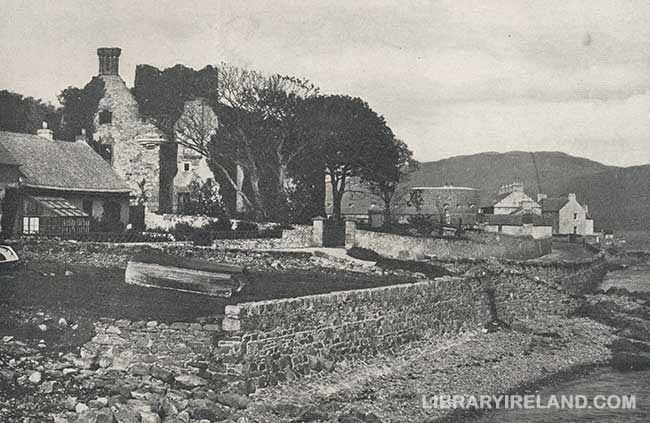Rathmullen
We soon arrived at Rathmullen, a historic spot where many things happened in the days of yore. It occupies a sheltered position at the foot of a range of hills that intervene between Lough Swilly and Mulroy Bay, of which the highest point is Crochanaffrin, one thousand one hundred and thirty-seven feet. It is worth while to make an excursion either up this hill or Croaghan, one thousand and ten feet, which is nearer; for the extraordinary view over the inlets and indentations of this singular coast will put the traveller more in mind of Norwegian fiords than British scenery. Close to it are the ivy-clad ruins of a priory of Carmelite friars, consisting of two distinct buildings erected at an interval of nearly two centuries. The eastern portion, of which the tower and chancel remain, was constructed by the McSweenys in the fifteenth century. It exhibits considerable traces of pointed Gothic architecture. Over the eastern window there still remains a figure of St. Patrick. The architecture of the remainder of the building is of the Elizabethan age, a great part of it having been rebuilt by Bishop Knox, of the diocese of Raphoe, in 1618, on obtaining possession of the manor of Rathmullen from Turlogh Oge McSweeny. The Annals of the Four Masters (to which we will refer later), states that in 1595 it was plundered by George Bingham, son of the Governor of Connaught. McSweeny's castle is supposed to have stood west of the priory, but it was destroyed in 1516. It was from here that the young Hugh O'Donnell was carried off in 1587, and kept a prisoner in Dublin until he made his romantic escape in 1591. In 1607, the Earls of Tyrone and Tyrconnell took their "flight" from Rathmullen in a small vessel. "The entire number on board was ninety-nine, having little sea-store, and being otherwise miserably accommodated." After a hazardous voyage of three weeks, they landed at the mouth of the Seine.

Rathmullen Abbey, County Donegal
There is a monument in the churchyard to the memory of the Hon. William H. Packenham, captain of the British man-of-war Saldanha, wrecked on Swilly Rock in 1811. Every soul on board was lost; the only living thing that reached the land was the captain's gray parrot, which the wind carried in safety to the rocky shore.
Here, too, Wolfe Tone was taken prisoner on board the French frigate Hoche, in 1798. Tone was a talented young Irishman, and pleaded the Irish cause so eloquently in Paris that a fleet of forty-three ships, with fifteen thousand men, was sent to Ireland in 1796, Hoche commanding. A tremendous storm scattered the fleet on the Irish coast, and the ships returned to France in broken order. Nothing daunted, Tone again persuaded the French to give him a trial with a new fleet. They gave it, but this expedition was even more unfortunate than the first one, and the end of Tone's tragic career dated from his arrest on the shores of Lough Swilly.
Read "On an Irish Jaunting Car through Donegal and Connemara" at your leisure
Read On an Irish jaunting Car through Donegal and Connemara at your leisure and help support this free Irish library.
Samuel Gamble Bayne was born in Ramelton, County Donegal, and educated at Queen's University in Belfast. At the age of twenty-five he left for America with a view to making his fortune. He invested in an oil well in Pennsylvania and later founded a bank which subsequently came to be the JP Morgan Chase bank in New York. By the time this book was written he was wealthy enough to be referred to as a billionaire. His account of the tour through the north, west and south of Ireland is a pleasant snapshot of how that part of the country was in the early part of the 20th century. He describes what is to be seen, gives some background history and, through the illustrations especially, provides wonderful glimpses of the area's social history.
The ebook is available in .mobi, .epub, and .pdf formats. See details ».

